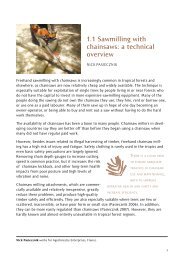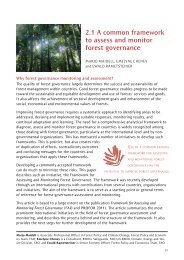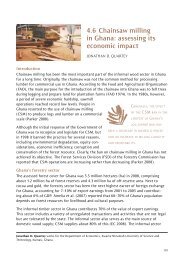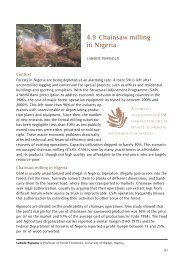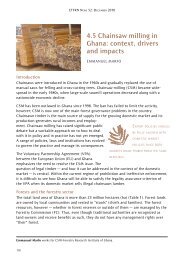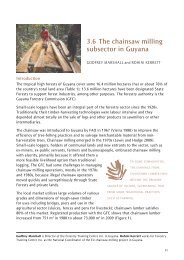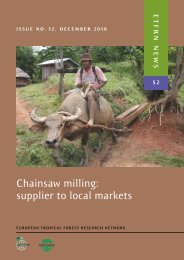Chainsaw milling: supplier to local markets - European Tropical ...
Chainsaw milling: supplier to local markets - European Tropical ...
Chainsaw milling: supplier to local markets - European Tropical ...
Create successful ePaper yourself
Turn your PDF publications into a flip-book with our unique Google optimized e-Paper software.
3.6 The chainsaw <strong>milling</strong><br />
subsec<strong>to</strong>r in Guyana<br />
GODFREY MARSHALL and ROHINI KERRETT<br />
introduction<br />
The tropical high forests of Guyana cover some 16.4 million hectares (ha) or about 76% of<br />
the country’s <strong>to</strong>tal land area (Table 1); 13.6 million hectares have been designated state<br />
Forests <strong>to</strong> support forest industries, among other purposes. The forestry authority is the<br />
Guyana Forestry Commission (GFC).<br />
small-scale loggers have been an integral part of the forestry sec<strong>to</strong>r since the 1920s.<br />
Traditionally, their timber-harvesting technologies were labour intensive and they<br />
depended almost <strong>to</strong>tally on the sale of logs and other products <strong>to</strong> sawmillers or other<br />
intermediaries.<br />
The chainsaw was introduced <strong>to</strong> Guyana by Fao in 1967 (Vieira 1980) <strong>to</strong> improve the<br />
efficiency of tree-felling practices and <strong>to</strong> salvage merchantable material from nonharvestable<br />
trees. <strong>Chainsaw</strong> <strong>milling</strong> emerged in the 1970s (lewis and hodge 2008).<br />
small-scale loggers, holders of communal lands and new entrants <strong>to</strong> the sec<strong>to</strong>r, such as<br />
ex-miners, ex-public servants, farmers and businesspeople, embraced chainsaw <strong>milling</strong><br />
with alacrity, primarily because it offered them a<br />
more feasible livelihood option than traditional<br />
logging. The GFC had some challenges in managing<br />
The earnings from<br />
chainsaw <strong>milling</strong> operations, mostly in the 1970s<br />
and 1980s, because illegal chainsaw opera<strong>to</strong>rs<br />
moved quickly and surreptitiously through state<br />
become The primary<br />
Forests and private lands.<br />
in some communiTies,<br />
chainsawn lumber have<br />
source of income, superseding ThaT<br />
from more TradiTional pracTices<br />
The <strong>local</strong> market utilizes large volumes of various<br />
grades and dimensions of rough-sawn timber<br />
such as farming.<br />
for uses including bridges, piers and use in the<br />
agricultural sec<strong>to</strong>r (sluices, fences and pens for lives<strong>to</strong>ck); chainsawn lumber satisfies<br />
80% of this market. registered production with the GFC shows that chainsawn lumber<br />
increased from 751 m3 in 1980 <strong>to</strong> about 73,000 m3 in 2009 (Figure 1).<br />
Godfrey marshall is Direc<strong>to</strong>r of the Forestry Training Centre inc. in Guyana. rohini Kerrett works for Forestry<br />
Training Centre inc. as the national Coordina<strong>to</strong>r of the Eu chainsaw <strong>milling</strong> project in Guyana.<br />
91



